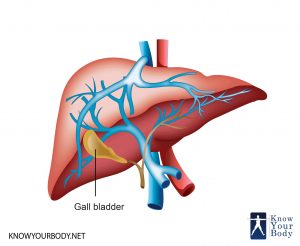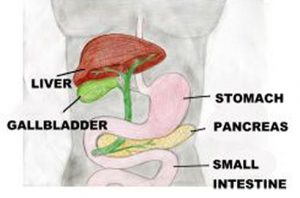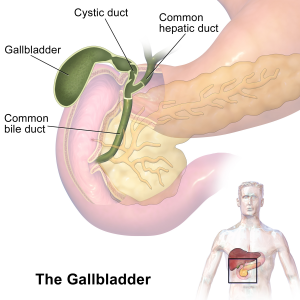The digestive system in human beings is one of the major controlling organ systems. With the incorporation of a number of organs, the system collectively controls the breakdown of the complex nutrient molecules into simple absorbable forms. All the organs perform differently but in a well-coordinated manner.
One of the small-sized yet important organs of the digestive system is the gallbladder.
What is the Gallbladder?
The gallbladder is present in all the species belonging to the chordate phylum of the Animalia kingdom. It is a hollow pouch-like organ which is concerned with the digestion process.
In human beings, this slightly elongated organ is pear-shaped, sitting below the liver. It stores the bile juice and makes it concentrated before releasing it into the duodenum for further digestion.
Location of the Gallbladder
The small pouch-shaped organ is located just below the liver and above the duodenum. The liver hides a small portion of the organ in the posterior region.
Parts of the Gallbladder
The four-inch organ is divided into the following parts:
- An almost conical in shape neck
- A slightly wider body
- A pouch like structured fundus
Gallbladder Structure
An adult gallbladder is located almost at the inlet side of the shallow notch of the liver. It is quite small as compared to the nearby organs as it is around 7 to 11 centimeters long while 4 cm wide. These measurements are an approximate value and are assumed to the dimension of the pouch when it is fully distended.
The structure of the gallbladder is quite typical as it resembles the pear fruit.
- The neck tapers at the top and opens into the cystic duct
- The fundus is rounded at the end. It faces the walls of the abdomen and is the only protruding part.
- The body of the gallbladder lies over the dent on the surface of the liver
- The gallbladder is accommodated in a depression like structure known as the gallbladder fossa.
- The gallbladder fossa is located amidst the right hepatic lobe of the liver and the medial division of the left hepatic lobe. It contains a little amount of fat tissue
- The cystic duct that arises from the neck of the gallbladder terminates into the hepatic duct arising from the liver. The fusion of these two ducts forms the CBT or the Common Bile Duct that opens into the duodenum.
- In the region where the neck meets the cystic duct, there is a small pouch-like outgrowth. This mucosal fold is termed as Hartmann’s pouch.
Internal Structure of Gallbladder
The internal anatomy of the gallbladder is little more complex owing to the various layers of the muscle fibers.
- The innermost layer of the gallbladder is composed of single layer columnar epithelium.
- These columnar cells are also accompanied by microvilli for increasing the surface area of secretion
- Next to the epithelial layer, is the layer of connective tissue known as lamina propria.
- The lamina propria is succeeded by a muscular layer
- The liver is protected by a double-layered serosa layer. The inner layer is the called the visceral layer while the external layer is the parietal serosa. A serous fluid is present in the cavity for lubricating the mesothelium membrane.
- The mucosa epithelial layer grows into tiny outgrowths known as rugae.
- The muscular layer contains muscle fibers that secrete bile while the contraction of the fibers.
Gallbladder Function
BILE STOREHOUSE
The main function of the pouched organ is to store bile till the cholecystokinin induces the contraction of the bladder walls and secretes the stored bile in the CBT.
Bile is important for:
- Emulsification of the fats: breakdown of larger fat molecules into smaller fat droplets
- The sodium, bicarbonate in the juice makes the medium of the duodenum alkaline. This alkaline medium activates the intestinal and pancreatic juices as they cannot work on the acidic chyme.
Bile is only released when food enters the esophagus. Till then the juice needs to be stored somewhere. This is done by the gallbladder. Upon receiving the neurogenic impulse, the muscular layer of the gallbladder contracts, thereby releasing the bile in the CBT.
Origin of the Gallbladder
The origin of the gallbladder is tracked down to the theory of the embryonic development of the zygote. After the fourth week of the embryogenic development process, the stomach has taken its place. the small intestine gives birth to a pouch-like outgrowth on the right side. This outgrowth is known as the hepatic diverticulum.
Below this biliary tree precursor, another small outgrowth is located. It is known as a cystic diverticulum. It is from this pouch, the gallbladder develops later through tissue differentiation and somatic cell division.
Gallbladder Innervation
The nerves that innervate the gallbladder are:
- Sympathetic nerve bundles arising from the Celius Plexus
- Vagus nerve’s parasympathetic nerves fibers
- Right phrenic nerve controls the sensory nerve bundles of the gallbladder
Gallbladder Pictures
Gallbladder Clinical Significance
Following are the clinical conditions of the gallbladder:
GALLSTONES
Gallstones are a condition where excess presence or bilirubin or cholesterol in the bile causes its saturation. This saturated bile finally turns into stones of varying in size. Gallstones can cause a number of problems since the gallbladder is linked to a number of important organs.
- When the stone increases in size, a sharp and shooting pain is caused on the right side of the abdomen.
- When the stones block the gallbladder, the condition is called cholecystitis
- If the stone blocks the biliary passage, jaundice is caused while if it interferes with the passage of the pancreatic duct, pancreatitis is caused.
- In most cases, surgical methods are adapted for the removal of gallstones if they cause some serious problems
- If the stones are too small, then drugs are allotted from the breakdown of the saturated stones
INFLAMMATION
Inflammation of the gallbladder occurs due to two main reasons:
- Blockage of the duct by the gallstones causes pressure on the walls. This pressure leads to the release of inflammatory chemicals like phospholipase.
- Sometimes inflammation is also a result of bacterial infection
Symptoms are fever and pain in the right side of the stomach. Antibiotics are given for reducing the inflammations.
REMOVAL OF THE GALLBLADDER
In this case, due to recurrent gallstone appearance or some other problems, the gallbladder is removed from the neck to the fundus. This condition is termed as cholecystectomy.
It is either done as open-wound surgery or through the microscopic, laparoscopic surgery.
CANCER
Cancer occurring in the gallbladder is quite uncommon and mostly occurs in late life. It can be caused because of:
- Gallbladder removal
- Gallstone recurrence
- Due to the lands adjacent to the gallbladder
Gallbladder FAQs
Why is gallbladder important?
The gallbladder is the storehouse of the bile juice. It is important because bile is not secreted only when food enters our system. Rather, liver continuously produces the juice and stores it in the gallbladder.
Are gallstones dangerous?
Gallstones are normally not harmful because saturation of bile occurs frequently. But if the problem persists and someone is experiencing sharp pain on the right side of the abdomen, then gallstones need to be removed.
Are gallstones recurrent?
This is quite controversial. The recurrence of the gallstones depends upon a number of factors. So that should be diagnosed by the doctor himself.
How are gallstones tracked?
Gallstones are generally examined through ultrasounds. Also, liver function tests and other blood test are done for seeing the extent of the infection.
What side of the body is your Gallbladder located?
It is located on the right side of your body under the liver.
What does the Gallbladder do?
Gallbladder helps in digesting the fat by making the bile concentrated and storing it as well.
Does pain on the right side of the abdomen means that gallbladder is infected?
There are a number of organs on the right side. Pain in that part does not signify that the gallbladder is the epicenter of the pain. Only a proper diagnosis can reveal the truth behind the pain.




No comments yet.